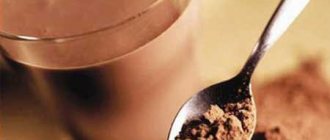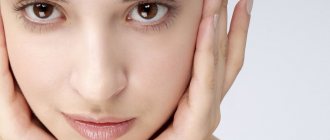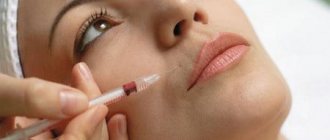- home
- Lipofilling
- Lipofilling of the upper and lower eyelids in Moscow
Lipofilling of the eyelids can be widely used as an independent operation. Indeed, with age, the layer of adipose tissue in the eyelid area becomes noticeably thinner, and the fat itself migrates and becomes deformed. Achieving the desired result in the shortest possible time, with a minimum rehabilitation period and with low risks and complications is the task that the patient sets for us. This may be why lipofilling of the face and, in particular, the eyelids is becoming increasingly popular. After all, lipofilling can meet all these requirements.
Why complications occur during eyelid lipofilling and how to avoid them
Work on the eyelid lipofilling method in order to obtain an “ideal” result is still ongoing. Such a feature as the unpredictability of the engraftment of fat autograft is not so significant today. But we pay special attention to the issue of the volume of one-time injection of fat.
World expert in the field of lipofilling, Doctor of Medical Sciences David Rubenovich Grishkyan says:
“Why do I consider this question to be the main one in obtaining the desired result in rejuvenating the lower eyelids? The widespread use of eyelid lipofling as a method of rejuvenating the periorbital area is hampered by the imperfection of the technology for introducing fatty autograft. It is known that the relative, at first glance, simplicity of the technique can play a “wicked joke” on the surgeon, leading to complications. But the complication of lipofilling can only be corrected surgically. »
Fat injection techniques for eyelid lipofilling
As a rule, when carrying out lipofilling, two main techniques are used. The first is the so-called “spraying” method. With this method, a small amount of fat is injected into a specific area using dozens of small strokes.
The second technique is the linear insertion technique. In our opinion, the first technique has a number of disadvantages. – Numerous movements of the cannula cause tissue injury. – Tissue swelling may interfere with the analysis of the results obtained. – It is difficult to control the volume of injection, especially if the surgeon does not have sufficient experience in performing the operation. – As a rule, the introduction of fat with this technique occurs when the cannula moves forward, which is fraught with complications. In his daily practice, surgeon D.R. Grishkyan uses the technique of slow retrograde linear injection of fat autograft. This technique allows you to carefully control the volume, layers and area of fat injection, avoiding overcorrection and vascular injury.
Multi-layering as a principle for introducing fat
The next point is the principle of introducing fat. An important factor is layering. We do not inject fat like a regular filler, but place the graft layer by layer according to the principle of building a pyramid. In this case, it is important from which layer to start adding fat. As a rule, we begin the introduction from the deep layers and then move higher to the skin. However, in some cases it is recommended to start the introduction from the superficial layers. The main choice of layer is the thickness of the leather.
Volume of administration
To correct the periorbital area, we introduce the volume of fat implant that we consider necessary. But the main thing that needs to be taken into account when mentioning the volume of injected fat is the size of the fat autograft . In our practice, we use fat implants of the smallest possible size, and it was the reduction in the size of the injected fat tissue and the combination of techniques that allowed us to increase the volume of injection, avoiding complications
What is lipofilling?
Fat grafting is the transplantation of the patient's own fat cells into the areas that need to be reconstructed.
The possibilities for using your own fat are wide. Aesthetic indications most often include correcting circles under the eyes, adding volume to the cheekbones or nasolabial furrows, and the corners of the mouth.
The fat used for lipofilling can be extracted by liposuction from any part of the body that has sufficient fat. The aspirate contains blood and tumescent solution in addition to the fat mixture. The extracted fat is separated using a centrifuge.
Fat cells are pumped into the area that needs volume filling with very thin cannulas. The transplanted fat is in direct contact with the surrounding tissues and quickly grows blood vessels. In principle, these are grafted living cells, or even fragments of adipose tissue. About 70% of fat survives forever. Therefore, lipofilling of the lower eyelids includes weak hypercorrection.
Lipofilling of the upper eyelids
Loss of volume in the upper eyelid region causes drooping of the lateral edge of the eyebrow and eyelid, creating the appearance of excess skin and ptosis of the upper eyelid.
The main indication for surgery is
- Skeletonization of the upper eyelid
- Age-related skeletonization of the upper eyelid caused by atrophy or migration of adipose tissue
- Skeletonization of the eyelid associated with the anatomical features and structure of the eyes
- Skeletonization resulting from excessive fat removal during upper eyelid surgery
In this case, lipofilling made it possible to correct the skeletonization and asymmetry of the upper eyelids.
When diagnosing a patient’s face before surgery, we perform a comprehensive analysis of the entire upper third of the face. By performing lipofilling of the upper eyelid, we are able to restore the volume. Sometimes we perform this procedure in combination with a lateral brow lift. This allows you to return the eyebrow to the correct anatomical position, and thereby solve the problem of excess skin of the upper eyelid, without resorting to traditional blepharoplasty.
In young patients under 40 years of age, in the absence of significant excess skin of the upper eyelid, this method gives significant aesthetic results. Lipofilling of the upper eyelid goes well with such rejuvenating operations as upper eyelid plastic surgery, forehead lifting, temple lifting, and circular facelift. In addition, it must be said that lipofilling of the upper eyelid is an extremely delicate operation. This is due to the fact that the skin of the upper eyelids is very thin, and any contouring of fat in this area will be noticeable.
Lipofilling of the upper eyelid is often performed together with lipofilling of the temporal zone and lipofilling of the eyebrow. Lipofilling of the uppermost eyelid is done in both the fixed and movable parts of the eyelid.
HOW IS EYE LIPO FILLING OPERATION PERFORMED?
The operation is performed under local anesthesia and usually lasts no more than 30 minutes. During this time, adipose tissue is taken from areas with excess amounts (abdomen, waist, hips). Next, after special treatment, the fat is injected into the sub-eyebrow area. Most often, lipofilling of the eyes is combined with lipofilling of other areas of the face: cheekbones, cheeks, forehead, chin. After the operation, you must stay in the hospital under the supervision of a plastic surgeon for several hours, and then you can safely go home.
RESULT AFTER EYE LIPO FILLING
Tight, smooth, beautiful and, most importantly, rejuvenated skin, correctly positioned eyebrows, clear, bright eyes - all these are the results of lipofilling, and not the action of a magic wand. Thousands and thousands of operations around the world confirm the effectiveness of this method in restoring youth. After the operation, youthful volume returns to the subeyebrow area, traces of false overhang (false, because visible excess skin on the upper eyelid is associated not with its stretching and weakening, but with a decrease in the fat pad - “weight loss” of the under-eyelid area) disappear without a trace, and to achieve a brighter results, eye lipofilling can be combined with blepharoplasty.
EYE LIPO FILLING PRICE
You can find out the price of eye lipofilling at the Abrielle plastic surgery clinic and get information about what is included in the total cost of the operation here.
Lipofilling of the lower eyelids
As for lipofilling of the lower eyelids, it is relevant both for pronounced tear troughs and in the presence of fatty protrusions (hernias). Pronounced tear trough is an extremely common problem. Moreover, it is observed not only in middle-aged patients who require full-fledged blepharoplasty, but also at a fairly young age.
The main reasons for the formation of unaesthetic depressions in the lower eyelids:
- With an anatomical tendency to a pronounced tear trough or features of the anatomical structure of the face with a lack of adipose tissue in the lower eyelids
- Consequences of traditional lower eyelid blepharoplasty with radical removal of fatty hernias
- Sudden weight loss, causing the development of skeletonization of this area of the face
What problems in the lower eyelid area can lipofilling help with?
Tear trough
Modern aesthetic surgery allows you to correct the tear trough, but when determining correction methods, a clear diagnosis of the causes of its formation is necessary. The most common reason is lack of volume. Consequently, lipofilling of the lower eyelids gives excellent aesthetic results in this case. Fat allows you not only to even out the area under the eyes, but also has a significant rejuvenating effect on the delicate skin of the eyelids. If the patient has excess skin, then lower eyelid plastic surgery is also indicated simultaneously with lipofilling.
In this case, lipofilling of the tear trough with correction of the zygomatic region was performed on a very young patient, 24 years old. The result continues to this day, for more than 8 years. Including after childbirth and breastfeeding.
Bags under the eyes
Another problem for patients seeking lower eyelid surgery is bags under the eyes. Often these patients do not realize that the problem exists at the tear trough level. The logic behind standard blepharoplasty is the decision to remove hernias in the lower eyelids down to the level of the tear trough. As a result, the patient receives either dark circles under the eyes, or, worse, drooping of the lower eyelids and an unaesthetic depression under the eyes.
In our opinion, the approach should be exactly the opposite. Adding volume during lipofilling of the lower eyelid to the area under the eyes allows not only to camouflage hernias. By equalizing differences in the levels of the hernia and the tear trough cavity, it is possible to achieve even, beautiful volumetric rejuvenation of the lower eyelid and skin. After all, the fat that we use for lipofilling contains a large number of growth factors that contribute to the rejuvenation of the eyelid skin.
Dark circles under the eyes
Another problem that lipofilling of the lower eyelids can cope with is dark circles under the eyes. A common cause of darkening of the skin around the eyes is the presence of closely spaced blood vessels and at the same time thin skin of the lower eyelids. In addition, dark circles are often the result of a pronounced tear trough, or skeletonization of the lower eyelid as a whole. In this case, lipofilling of the lower eyelid becomes the only option for solving the problem.
Dark circles under the eyes can occur due to various reasons. In this case, thin skin and anatomical structure caused hernias and dark circles in a very young patient. Lipofilling of the lower eyelids is the only way to completely natural and long-term solution to this problem.
Determination and implementation of lipofilling
Fat grafting, including the eyes, as mentioned above, is a transplantation of fat from one area of the body to another.
Photos of the lipofilling procedure before and after
You may be interested in other articles on the topic: Lipofilling of lips Lipofilling of hands Lipofilling of breasts
The procedure is carried out in two steps:
- Lipoaspiration, that is, sampling of adipose tissue. It is worth noting that fat from the knee area is most often used for lipofilling of the eyelids. After all, here it is the smallest, and, in addition, it is distinguished by its excellent adaptability for taking root on the face. Fat is collected using a special ultra-thin and small needle with several holes (cannulas). The size of the fat cells taken depends on the diameter of the holes. The smaller they are, the better.
- The intermediate stage in this case is the preparation of the collected fat. After all, it cannot be transferred untreated to the eye area. Biomass is added to the fat, which is enriched with platelet autoplasma. This technique makes it possible to activate rejuvenating mechanisms. As a result, skin tightness after the lipofilling procedure under the eyes and above them remains for a long period.
- The resulting enriched fat is injected into those areas around the eyes where there are cosmetic problems. The procedure is performed using even thinner needles called microcannulas. This makes it possible to get rid of injuries. A skilled surgeon is able to perform the procedure without damaging a single nerve or vessel. The skin is pierced with extreme care.
It is worth noting that lipofilling of the lower eyelids, lipofilling of the upper eyelids, as well as lipofilling in the area under and above the eyeball can be performed.
Rehabilitation during eyelid lipofilling
Lipofilling of the eyelids, like any other lipofilling, is a low-traumatic procedure. It can be performed under local anesthesia, and the patient leaves the clinic on the day of the operation. After lipofilling of the eyelids, as a rule, there are no bruises or scars left on the face, and swelling is minor and goes away on its own within two weeks. The main injury occurs in the area of the donor zones; bruising and swelling may remain there. This is especially possible if the patient simultaneously underwent full liposuction or more extensive lipofilling than just lipofilling of the eyelids. In this case, compression garments and physiotherapeutic procedures are recommended. To prevent the survival of fat and accelerate vascularization, it is recommended to perform several procedures of placental therapy.
After operation
Many people are concerned about the question: after what period after eyelid lipofilling can you go back to work? It is difficult to answer this unequivocally. After all, much depends on the characteristics of each individual organism.
After the lipofilling procedure
!Many of those who have had lipofilling of the upper eyelids, lipofilling of the lower eyelids, or the entire area around the eyes even refuse to rest after the intervention. However, experts recommend staying overnight at the clinic, under the supervision of medical staff. After all, at this time the recovery from anesthesia is still underway. And after half a day you can go home. If we talk about work, it is worth noting that for several days after lipofilling of the eyes, some swelling will be noticeable on the face, and the bridge of the nose will be somewhat widened. After 7-10 days, all these consequences disappear, and you can safely go to your workplace. Colleagues and acquaintances will only notice a fresher and younger face.
From the moment the consequences of the intervention completely disappear, the patient’s eyes become more open and tightened. This is evidenced by numerous photographs of eye lipofilling, demonstrating how patients have changed after the procedure.
Blepharoplasty and lipofilling are popular methods of cosmetic surgery.
It is worth noting that eye lipofilling is a more painless procedure than the often used blepharoplasty. After all, the latter involves the removal of excess stretched skin, as well as infraorbital and supraorbital hernias. The surgeon simply carefully cuts out the problem areas by making incisions in the skin above and below the eyelids. There are cases when the skin is cut from the inside, then such an intervention is called transconjunctival blepharoplasty.
Photos before and after lipofilling
This operation can be performed under general or local anesthesia. Hematomas after surgery usually resolve within a couple of weeks.
There is also a dual lift eyelid correction technique, which involves filling the nasolacrimal trough with the patient’s own fat. This technique has become increasingly widespread in recent months. In some ways, dual lift eyelid correction can be called exclusive blepharoplasty. During this procedure, the integrity of the orbicularis oculi muscle is maintained. Dual lift eyelid correction is carried out in two zones: hernias are removed transconjunctivally, and excess skin is excised without affecting the muscle. The rehabilitation period after dual lift correction lasts 4-5 days.











